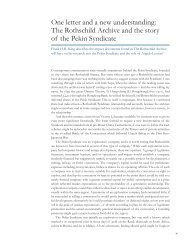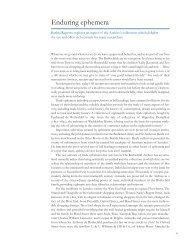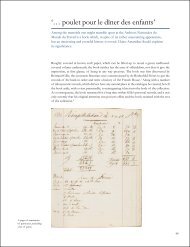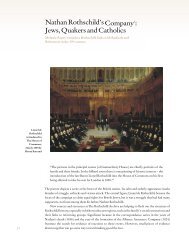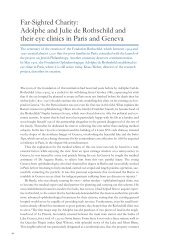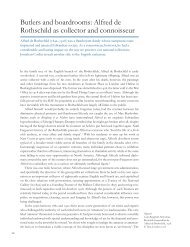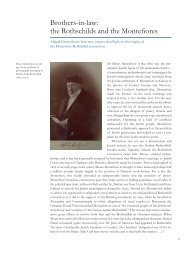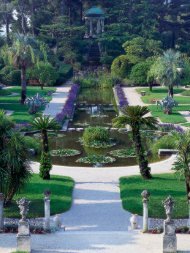Beatrice Ephrussi de Rothschild: creator and collector
Beatrice Ephrussi de Rothschild: creator and collector
Beatrice Ephrussi de Rothschild: creator and collector
Create successful ePaper yourself
Turn your PDF publications into a flip-book with our unique Google optimized e-Paper software.
Béatrice <strong>Ephrussi</strong> <strong>de</strong> <strong>Rothschild</strong>:<br />
<strong>creator</strong> <strong>and</strong> <strong>collector</strong><br />
Dr Ulrich Leben, a member of the research team exploring the contributions<br />
ma<strong>de</strong> by members of the <strong>Rothschild</strong> family to the cultural life of France, presents<br />
a summary of the life <strong>and</strong> collections of Béatrice <strong>Ephrussi</strong> <strong>de</strong> <strong>Rothschild</strong>.<br />
opposite<br />
The Temple of Love in<br />
the gar<strong>de</strong>ns at the Musée<br />
<strong>Ephrussi</strong> <strong>Rothschild</strong>.<br />
(Lionel <strong>de</strong> <strong>Rothschild</strong>)<br />
I hereby bequeath to the Institut <strong>de</strong> France, for the Académie <strong>de</strong>s Beaux-Arts, the Villa Ile <strong>de</strong> France,<br />
in Saint Jean Cap Ferrat, together with all the works of art <strong>and</strong> furniture, <strong>and</strong> the gar<strong>de</strong>ns surrounding the<br />
villa, for the purposes of creating a museum … To this new museum, I bequeath all my works of art, whether<br />
in Paris, 19, avenue Foch, or in the Villa Soleil <strong>and</strong> the Villa Rose <strong>de</strong> France in Monte Carlo: paintings,<br />
furniture, porcelain, tapestry, etc. It is my wish that as much as possible the museum keeps its current<br />
appearance as a salon, <strong>and</strong> that the valuable pieces are kept behind glass.<br />
Thus read the clause in Béatrice <strong>Ephrussi</strong> <strong>de</strong> <strong>Rothschild</strong>’s will, which secured the future of her<br />
art collection, now in the legendary Musée <strong>Ephrussi</strong> <strong>Rothschild</strong> on the Cote d’Azur. However,<br />
<strong>de</strong>spite thous<strong>and</strong>s of visitors to the villa every year, by <strong>Rothschild</strong> st<strong>and</strong>ards comparatively little<br />
is known of the extraordinary woman who <strong>de</strong>vised this collection <strong>and</strong> its setting. By piecing<br />
together small <strong>de</strong>tails from various sources a more vivid picture of Béatrice emerges.¹<br />
Béatrice <strong>de</strong> <strong>Rothschild</strong> was born in Paris on 14 September 1864, the daughter of Alphonse<br />
<strong>de</strong> <strong>Rothschild</strong> <strong>and</strong> his wife Leonora, <strong>and</strong> the gr<strong>and</strong>daughter of James, foun<strong>de</strong>r of the French<br />
branch of the family, <strong>and</strong> his wife, the celebrated society hostess Betty. In 1883 she married<br />
Maurice <strong>Ephrussi</strong> (1849–1916), who was himself a member of a banking family originating in<br />
Russia.²<br />
Following their marriage the couple divi<strong>de</strong>d their time between Paris <strong>and</strong> their country<br />
properties.³ Maurice had a vast stud at chateau <strong>de</strong> Reux, Pont l’Eveque; Béatrice, with a welldocumented<br />
penchant for gambling, was a regular visitor to the Deauville casino. Having no<br />
children the couple were inveterate travellers, passing many months on board their yacht in the<br />
waters of Europe <strong>and</strong> beyond.<br />
In spite of the fact that she had always lived without financial worries it was the inheritance<br />
that she received on the <strong>de</strong>ath of her father in 1905 that seems to have been the catalyst for<br />
Béatrice’s building projects. In the very year of his <strong>de</strong>ath she acquired one of Cap Ferrat’s most<br />
beautiful sites <strong>and</strong> began the construction of the villa Ile <strong>de</strong> France<br />
Tired of sitting at the gaming table in Monte Carlo, she wished to breathe some fresh air<br />
<strong>and</strong> went to Cap Ferrat’s upl<strong>and</strong>s. There, she stepped out of her car. She enjoyed the slight<br />
slope, which went up through the olive, pistachio, <strong>and</strong> pine trees, <strong>and</strong> sud<strong>de</strong>nly she found<br />
herself at the top of a hill, from where she could set her sights, simultaneously, on a<br />
double bay: the harbour of Villefranche <strong>and</strong> the bay of Beaulieu, <strong>and</strong> there she thought:<br />
‘this l<strong>and</strong>scape is equivalent to the Inl<strong>and</strong> Sea in Japan, the most beautiful site in the<br />
world: water, mountains, reflections, horizons, I want it’.<br />
It is in these words, <strong>and</strong> using a perfectly imaginary <strong>de</strong>scription, albeit well suited to the spirit<br />
of the time <strong>and</strong> of its author, that Elisabeth <strong>de</strong> Gramont recounted the heart-stopping experience<br />
which would create the impetus for the construction of the Villa Ile <strong>de</strong> France.⁴<br />
In<strong>de</strong>ed, Béatrice conceived her property, which overlooks the sea on three of its si<strong>de</strong>s, as a<br />
liner drifting along the quiet Mediterranean waters, the house opening onto a gigantic bridge<br />
23




